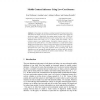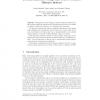LOCA
2005
Springer
14 years 9 months ago
2005
Springer
Context information is used by pervasive networking and context-aware programs to adapt intelligently to different environments and user tasks. As the context information is poten...
LOCA
2005
Springer
14 years 9 months ago
2005
Springer
In this paper, we introduce a compact system for fusing location data with data from simple, low-cost, non-location sensors to infer a user’s place and situational context. Speci...
LOCA
2005
Springer
14 years 9 months ago
2005
Springer
Services in pervasive computing systems must evolve so that they become minimally intrusive and exhibit inherent proactiveness and dynamic adaptability to the current conditions, u...
LOCA
2005
Springer
14 years 9 months ago
2005
Springer
Abstract. Navigation for and tracking of humans within a building usually implies significant infrastructure investment and devices are usually too high in weight and volume to be...
LOCA
2005
Springer
14 years 9 months ago
2005
Springer
Abstract. We present an improvement to ultrasound–based indoor location systems like Cricket [1]. By encoding and modulating the ultrasound pulses, we are able to achieve greater...
LOCA
2005
Springer
14 years 9 months ago
2005
Springer
Abstract. This paper investigates the efficiency of in-door next location prediction by comparing several prediction methods. The scenario concerns people in an office building vis...
LOCA
2005
Springer
14 years 9 months ago
2005
Springer
This paper presents the design, implementation, and evaluation of a footprintbased indoor location system on traditional Japanese GETA sandals. Our footprint location system can s...
LOCA
2005
Springer
14 years 9 months ago
2005
Springer
Abstract. In this paper we identify the common techniques and technologies that are enabling location identification in a ubiquitous computing environment. We also address the imp...
LOCA
2005
Springer
14 years 9 months ago
2005
Springer
In this paper, we present a robust, decentralized approach to RF-based location tracking. Our system, called MoteTrack, is based on low-power radio transceivers coupled with a mode...
LOCA
2005
Springer
14 years 9 months ago
2005
Springer
Today, most mobile applications use geo-referenced points of interest (POIs) on location-based maps to call the user’s attention to interesting spots in the surroundings. The pre...


